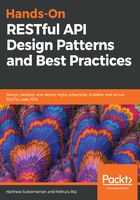
Understanding the uniform interface
As we mentioned earlier in the uniform interface section as part of ROA, REST-based services can use the HTTP interface, such as GET, POST, PUT, DELETE, and so on, to maintain uniformity across the web. The intention of a uniform interface is to retain some common vocabulary across the internet. For example, GET does mean to get (read) something from the server. The services can independently evolve as their interfaces simplify and decouple the architecture, and the uniform interface brings a uniform vocabulary to those resources as well. The following diagram depicts the combination of HTTP Methods and the Resource Names for Uniform Interfaces:

There are four guiding principles suggested by Fielding that constitute the necessary constraints to satisfy the uniform interface, and they are as follows:
- Identification of resources
- Manipulation of resources
- Self-descriptive messages
- Hypermedia as the engine of application state
We will see each constraint in detail in the following sections.